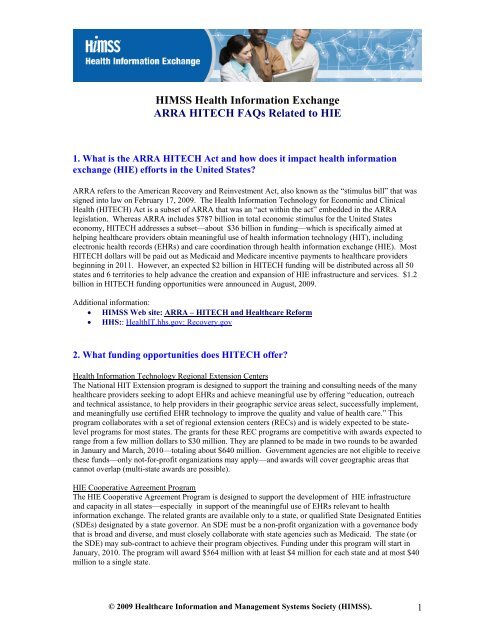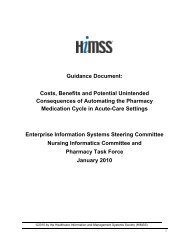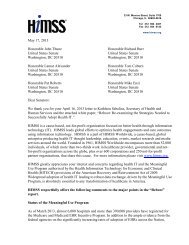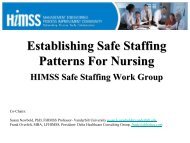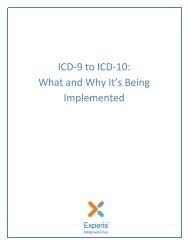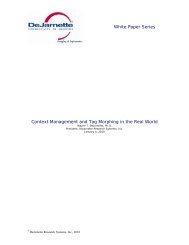HIE HITECH ARRA Fact Sheet - himss
HIE HITECH ARRA Fact Sheet - himss
HIE HITECH ARRA Fact Sheet - himss
You also want an ePaper? Increase the reach of your titles
YUMPU automatically turns print PDFs into web optimized ePapers that Google loves.
HIMSS Health Information Exchange<br />
<strong>ARRA</strong> <strong>HITECH</strong> FAQs Related to <strong>HIE</strong><br />
1. What is the <strong>ARRA</strong> <strong>HITECH</strong> Act and how does it impact health information<br />
exchange (<strong>HIE</strong>) efforts in the United States?<br />
<strong>ARRA</strong> refers to the American Recovery and Reinvestment Act, also known as the “stimulus bill” that was<br />
signed into law on February 17, 2009. The Health Information Technology for Economic and Clinical<br />
Health (<strong>HITECH</strong>) Act is a subset of <strong>ARRA</strong> that was an “act within the act” embedded in the <strong>ARRA</strong><br />
legislation. Whereas <strong>ARRA</strong> includes $787 billion in total economic stimulus for the United States<br />
economy, <strong>HITECH</strong> addresses a subset—about $36 billion in funding—which is specifically aimed at<br />
helping healthcare providers obtain meaningful use of health information technology (HIT), including<br />
electronic health records (EHRs) and care coordination through health information exchange (<strong>HIE</strong>). Most<br />
<strong>HITECH</strong> dollars will be paid out as Medicaid and Medicare incentive payments to healthcare providers<br />
beginning in 2011. However, an expected $2 billion in <strong>HITECH</strong> funding will be distributed across all 50<br />
states and 6 territories to help advance the creation and expansion of <strong>HIE</strong> infrastructure and services. $1.2<br />
billion in <strong>HITECH</strong> funding opportunities were announced in August, 2009.<br />
Additional information:<br />
• HIMSS Web site: <strong>ARRA</strong> – <strong>HITECH</strong> and Healthcare Reform<br />
• HHS:: HealthIT.hhs.gov: Recovery.gov<br />
2. What funding opportunities does <strong>HITECH</strong> offer?<br />
Health Information Technology Regional Extension Centers<br />
The National HIT Extension program is designed to support the training and consulting needs of the many<br />
healthcare providers seeking to adopt EHRs and achieve meaningful use by offering “education, outreach<br />
and technical assistance, to help providers in their geographic service areas select, successfully implement,<br />
and meaningfully use certified EHR technology to improve the quality and value of health care.” This<br />
program collaborates with a set of regional extension centers (RECs) and is widely expected to be statelevel<br />
programs for most states. The grants for these REC programs are competitive with awards expected to<br />
range from a few million dollars to $30 million. They are planned to be made in two rounds to be awarded<br />
in January and March, 2010—totaling about $640 million. Government agencies are not eligible to receive<br />
these funds—only not-for-profit organizations may apply—and awards will cover geographic areas that<br />
cannot overlap (multi-state awards are possible).<br />
<strong>HIE</strong> Cooperative Agreement Program<br />
The <strong>HIE</strong> Cooperative Agreement Program is designed to support the development of <strong>HIE</strong> infrastructure<br />
and capacity in all states—especially in support of the meaningful use of EHRs relevant to health<br />
information exchange. The related grants are available only to a state, or qualified State Designated Entities<br />
(SDEs) designated by a state governor. An SDE must be a non-profit organization with a governance body<br />
that is broad and diverse, and must closely collaborate with state agencies such as Medicaid. The state (or<br />
the SDE) may sub-contract to achieve their program objectives. Funding under this program will start in<br />
January, 2010. The program will award $564 million with at least $4 million for each state and at most $40<br />
million to a single state.<br />
© 2009 Healthcare Information and Management Systems Society (HIMSS). 1
EHR Adoption Loan Program<br />
This is a federal grant program in which states are the grantees that, in turn, use the money to fund a loan<br />
program to healthcare providers to purchase, use, support, and provide training on EHRs and secure<br />
electronic health information exchange. The loans can be made to purchase EHRs, utilize EHRs (including<br />
upgrades to meet meaningful use objectives), train personnel, and improve <strong>HIE</strong>. The loans can be made<br />
below market interest rates for up to 10 years. Specifics on this program have not yet been announced by<br />
the Office of the National Coordinator for Health Information Technology (ONC.)<br />
Workforce Training Grants<br />
This grant program is designed to integrate informatics training into programs for educating those in the<br />
healthcare professions—especially physicians, nurses, physician assistants and dentists. There is also a<br />
training program grant that focuses on expanding training in medical informatics to both health<br />
professionals and information technology professionals. ONC has recently announced the availability of<br />
$80 million in grants – $70 million for community college training programs and $10 million to develop<br />
educational materials to support these programs. Details of this program will follow.<br />
Healthcare Information Enterprise Integration Research Centers<br />
This grant program contains funding for eligible institutions to establish centers for research in health<br />
information integration. Announcements from the government regarding the details of the funding have<br />
not been published yet.<br />
Medicare/Medicaid EHR Adoption Incentives<br />
This is an incentive program in which about $36 billion (approx $20 billion net) is set aside to reward<br />
Medicaid and Medicare providers for meaningful use of EHRs. The Medicaid program and the Medicare<br />
program have significant tactical differences. The Medicaid program is a reimbursement program for EHR<br />
adoption that will be administered by each state with reimbursements that may be as large as $65,000 per<br />
eligible professional (physician, dentist, certified nurse mid-wife, nurse practitioner, and certain physician<br />
assistants). The Medicare program provides up to $44,000 ($48,500 for those in healthcare shortage areas)<br />
through 2015 per eligible professional (physician, dentist, optometrist, podiatrist, and [limited]<br />
chiropractors). The Medicare program also has a penalty phase that withholds an increasing percentage of<br />
Medicare reimbursements for non-EHR adoption starting in 2016. These programs also are extended to<br />
hospitals and federally qualified health centers. Healthcare providers may participate in only one of these<br />
two programs; it not yet clear whether hospitals are eligible to participate in both programs simultaneously.<br />
Beacon Community Cooperative Agreement Program<br />
This grant program is aimed at established communities with the goal of building upon existing technical<br />
infrastructure to enhance the community’s ability to achieve meaningful use through a wide variety of<br />
possible activities. Communities must already have 30% adoption of EHR systems (25% in rural areas),<br />
and funding cannot be used to support EHR adoption for providers already eligible for CMS incentives.<br />
$220 million will be available over 36 months to fund up to fifteen qualified applicants through a<br />
cooperative agreement with ONC. Awards, which are expected to be made in March 2010, will be between<br />
$10 and $20 million. Eligible applicants include not-for-profit and government agencies.<br />
Addition information:<br />
• HHS: HealthIT.hhs: Funding Opportunities<br />
• Medicare and Medicaid Health Information Technology: TITLE IV OF THE AMERICAN<br />
RECOVERY AND REINVESTMENT ACT<br />
• HIMSS Web site: <strong>ARRA</strong> – <strong>HITECH</strong> and Healthcare Reform<br />
© 2009 Healthcare Information and Management Systems Society (HIMSS). 2
3. I keep hearing about “Meaningful Use.” What does that mean and how is that<br />
relevant to qualifying for <strong>HITECH</strong> incentives?<br />
The <strong>HITECH</strong> Act requires that providers demonstrate “meaningful use” of health information technology<br />
to receive <strong>HITECH</strong> incentives. The text of the Act indicates that meaningful use includes electronic<br />
prescribing, electronic exchange of health information, and submission of information on clinical quality<br />
measures. The intended approach to meeting the meaningful use guidelines is for providers to use an EHR<br />
in conjunction with and <strong>HIE</strong> of some type. ONC provided draft guidelines on Meaningful Use in June,<br />
2009 and a modified version in July, 2009. The draft guidelines propose three sets of criteria, one each for<br />
2011, 2013 and 2015. Conceptually, the 2011 criteria address capture and sharing of data; the 2013 criteria<br />
address advanced care processes with decision support; and the 2015 criteria address improved outcomes.<br />
The proposed rule making process for Meaningful Use is anticipated to be released in December, 2009.<br />
Additional Information:<br />
• HHS: healthit.hhs.gov: Meaningful Use<br />
• HIMSS Economic Stimulus for the Healthcare IT Industry<br />
4. How is <strong>HIE</strong> relevant to achieve Meaningful Use?<br />
To meet the definition of meaningful use, it is expected that healthcare providers will implement and use an<br />
EHR and then exchange information electronically with other healthcare organizations. While <strong>HIE</strong> is not<br />
overtly required in the draft meaningful use definition, several of the requirements are services or<br />
capabilities commonly offered or facilitated by <strong>HIE</strong>s. Furthermore, the <strong>HITECH</strong> Act includes funding for<br />
states to create and/or grow their <strong>HIE</strong> infrastructure to help providers prepare for and meet meaningful use.<br />
The final meaningful use guidelines are expected to be written such that providers will have a path to meet<br />
the definition whether or not they are in a community with an established <strong>HIE</strong>.<br />
5. Where can providers go for assistance and support?<br />
There are several sources of support that may be available to providers, including:<br />
• Regional extension centers (RECs), as mandated in the economic stimulus legislation, will provide<br />
direct support to providers. These centers will provide technical assistance and help with<br />
implementation for both physicians and hospitals, from selecting vendors to changing workflow<br />
patterns to improving clinical performance. The names, contact information, and service areas for<br />
regional extension centers will be published by ONC when available.<br />
• EHR system vendors are a key source of support. Services are sometimes bundled with software<br />
purchase or may be priced separately. Authorized (and unaffiliated) third-party vendors often<br />
supplement vendor support.<br />
• <strong>HIE</strong>s may provide support for EHR systems and for <strong>HIE</strong> implementation.<br />
• Professional societies and organizations (e.g., hospital associations, local medical associations, or local<br />
chapters of national medical associations) may provide additional support for their members or others<br />
in the community.<br />
6. How should a hospital prepare to achieve the <strong>HIE</strong> requirement/aspects of<br />
meaningful use?<br />
© 2009 Healthcare Information and Management Systems Society (HIMSS). 3
Hospitals can take several steps, including:<br />
o Hospitals should take an inventory of the ways that health information is currently exchanged, both<br />
within their organization and to outside entities. This may include demographic data, lab results,<br />
immunization and disease registries, e-prescribing, public health disease and syndromic surveillance.<br />
o Hospitals should also review local or regional <strong>HIE</strong> activities that are taking place in the community.<br />
o Hospitals should review the state’s strategy for <strong>HIE</strong>. States are now developing their <strong>HIE</strong> strategic<br />
plans under the state coorperative agreement program . Hospitals need to understand the options and<br />
resources available to support their involvement in achieving exchange of health information.<br />
o Hospitals should then define their strategy for extending their ability to exchange health information<br />
and stay informed as the 2013 and 2015 health information exchange meaningful use requirements<br />
are defined.<br />
7. How should a physician practice prepare to achieve the <strong>HIE</strong> requirement/aspects<br />
of meaningful use?<br />
Physicians can take several steps, including:<br />
o Physician practices should first take an inventory of the ways that health information is currently<br />
exchanged within the practice. This may include demographic data, lab results, PQRI data, or<br />
immunization data.<br />
o Physician practices should also review local or regional <strong>HIE</strong> activities that are taking place in the<br />
community, including reference labs, hospitals or other organizations.<br />
o Physician practices should review the state’s strategy for <strong>HIE</strong>. States are now developing their <strong>HIE</strong><br />
strategic plans under the state cooperative agreement program. Physician practices need to<br />
understand options and resources available to support their involvement in achieving exchange of<br />
health information.<br />
o Physician practices should then define their strategy for exchanging health information and stay<br />
informed as the 2013 and 2015 health information exchange meaningful use requirements are<br />
defined.<br />
8. What is a regional extension center?<br />
<strong>HITECH</strong> allows funding for 70 or more regional centers, each serving a defined, non-overlapping<br />
geographic area. Each REC should be a U.S.-based nonprofit organization with established support and<br />
recognition within the local communities they propose to serve. The REC should focus effort on individual<br />
and small group practices (
ONC required that each state establish a State Government Health Information Technology (IT)<br />
Coordinator as part of the <strong>HIE</strong> cooperative agreement application, and encouraged states to be involved in<br />
the selection of REC candidates. RECs are meant to operate independent of state governments.<br />
10. Do <strong>HIE</strong>s have a role in regional extension centers?<br />
In the <strong>ARRA</strong> <strong>HITECH</strong> law, there is no linkage between RECs and <strong>HIE</strong>s (called health information<br />
organizations by ONC) but coordination is encouraged. The REC application asks for letters of support<br />
from <strong>HIE</strong>s and coordination with <strong>HIE</strong>s is referenced in the application. Similarly, the application for<br />
funding for the state <strong>HIE</strong> cooperative agreement program asks how the development of the state <strong>HIE</strong> will<br />
coordinate with the RECs to support meaningful use. As each state determines how to manage <strong>HIE</strong> itself<br />
or selects a state designated entity (SDE) to manage <strong>HIE</strong>, the state or SDE is likely to realize that a close<br />
working relationship between the statewide <strong>HIE</strong> entity and the RECs serving the state makes substantial<br />
sense. In some cases, an organization operating an <strong>HIE</strong> may apply for funding as an REC so long as the<br />
organization meets the program requirements.<br />
11. What is known about the type of state agencies or organizations that are<br />
applying to be extension centers?<br />
According to the funding application, the REC candidate entities are to be United States-based, non-profit<br />
organizations that are established and recognized in the communities they propose to serve. REC<br />
candidates need to demonstrate a track record in providing support to EHR implementations and a REC<br />
must be organized or capable of being organized to provide such support to at least 1,000 priority primary<br />
care providers in the first two years of the four-year agreement. This must represent at least 20% of the<br />
total primary care providers in the proposed service area. Priority providers are primary care providers<br />
(physicians, nurse practitioners and physician assistants) in individual and small group practices (< 10<br />
professionals) primarily focused on primary care, public and critical access hospitals, community health<br />
and rural health centers and other setting serving predominantly un-insured, underinsured and medically<br />
underserved populations.<br />
Once the applications are received and awards made by ONC, a more accurate picture of REC organization<br />
profiles will become available.<br />
12. What is the State <strong>HIE</strong> Cooperative Agreement Program?<br />
The State <strong>HIE</strong> Cooperative Agreement Program is designed to support the development of health<br />
information exchange infrastructure and capacity in all states—especially in support of the meaningful use<br />
of EHRs relevant to <strong>HIE</strong>. The related grants are available only to a state, or qualified SDE designated by a<br />
state governor. An SDE must be a non-profit organization with a governance body that is broad and<br />
diverse, and must closely collaborate with state agencies such as Medicaid. The state (or the SDE) may<br />
sub-contract to achieve their program objectives. Funding under this program will start in January, 2010.<br />
The program will award $564M with at least $4M for each state and at most $40M to a single state.<br />
Additional Information:<br />
• HHS: State Health Information Exchange Cooperative Agreement<br />
© 2009 Healthcare Information and Management Systems Society (HIMSS). 5
13. What is the state governments’ role in <strong>HIE</strong> State Cooperative Agreements?<br />
According to the ONC Funding Opportunity Announcement (FOA), states and/or their SDEs are to use<br />
their authority, programs, and resources to:<br />
• Develop state-level directories and enable technical services for <strong>HIE</strong> within and across states;<br />
• Remove barriers and create enablers for <strong>HIE</strong>, particularly those related to interoperability across<br />
laboratories, hospitals, clinician offices, health plans and other health information trading partners;<br />
• Convene healthcare stakeholders to ensure trust in and support for a statewide approach to <strong>HIE</strong>;<br />
• Ensure that an effective model for <strong>HIE</strong> governance and accountability is in place;<br />
• Coordinate an integrated approach with Medicaid and state public health programs to enable<br />
information exchange and support monitoring of provider participation in <strong>HIE</strong> as required for<br />
Medicaid meaningful use incentives;<br />
• Develop or update privacy and security requirements for <strong>HIE</strong> within and across state borders; and<br />
• Coordinate activities across Medicaid and state public health programs, to avoid duplicate efforts<br />
and to ensure integration and support of a unified approach to information exchange.<br />
14. What is known about the type of state agencies or organizations that are<br />
applying for State <strong>HIE</strong> Cooperative Agreement Program funding?<br />
Under the <strong>ARRA</strong> <strong>HITECH</strong> law, states have been required to appoint a State Government Health IT<br />
Coordinator and the state must submit a request for either an <strong>HIE</strong> planning grant or an <strong>HIE</strong> implementation<br />
grant. The actual applicant can be either the state itself or an SDE that acts for the benefit of the state to<br />
manage <strong>HIE</strong>. In many states, there has been a fast-paced program to identify or form an organization that<br />
meets the SDE requirements. In some states, multiple organizations found themselves in competition to be<br />
their states SDE. In other states, which had a single state entity responsible for <strong>HIE</strong> at the time that <strong>ARRA</strong><br />
<strong>HITECH</strong> was passed in February, 2009, the existing state agency or statewide independent entity will likely<br />
be the applicant.<br />
Once the applications are received and awards made by ONC, a more accurate picture of state or SDE<br />
organization profiles will become available.<br />
15. I hear that my EHR software must be ‘certified’ to qualify for <strong>HITECH</strong><br />
incentives. What does that mean?<br />
In August, 2009 the Certification and Adoption Workgroup gave recommendations to the HIT Policy<br />
Committee. They proposed that, “HHS Certification means that a system is able to achieve the minimum<br />
government requirements for security, privacy, and interoperability, and that the system is able to produce<br />
the Meaningful Use results that the government expects.”* In other words, certification should be focused<br />
on the capability to achieve meaningful use, not feature/function. They also recommended multiple<br />
certification organizations, and that the National Institute of Standards and Technology (NIST) assist in the<br />
establishment of an accreditation organization and process. In addition, they recommended the leverage of<br />
existing certification work primarily conducted by the Certification Commission for Health Information<br />
Technology (CCHIT).<br />
The certification process will be codified in a December, 2009 Notice of Proposed Rulemaking and will<br />
define the process for certifying EHRs including modular and open source approaches. After a comment<br />
period, the final certification process and criteria will be available sometime in Spring, 2010.<br />
© 2009 Healthcare Information and Management Systems Society (HIMSS). 6
*http://healthit.hhs.gov/portal/server.pt?open=18&objID=878086&parentname=CommunityPage&parenti<br />
d=53&mode=2&in_hi_userid=11113&cached=true<br />
16. Do <strong>HIE</strong>s also need to be certified?<br />
No, the <strong>HITECH</strong> Act does not require that <strong>HIE</strong>s be certified. In August, 2009 CCHIT froze the 2009<br />
certification program for <strong>HIE</strong>s, and in October, 2009 CCHIT announced the following: “We are not<br />
offering a CCHIT Certified® Comprehensive program for Health Information Exchanges (<strong>HIE</strong>s) at this<br />
time. We will continue to monitor the environment to determine if a need for Comprehensive certification<br />
becomes apparent as the policies and programs of the US Department of Health and Human Services<br />
unfold.”**<br />
**http://www.cchit.org/get_certified/open_hie<br />
17. What is public health’s role or involvement in <strong>ARRA</strong> <strong>HITECH</strong>-funded<br />
activities?<br />
Public’s health role will differ depending on the choices made by a particular state or region. All three of<br />
the major funded activities have the potential to involve public health as a significant participant:<br />
• Funding through the Centers for Medicare & Medicaid (CMS) for EHR system deployment to primary<br />
care providers and hospitals can build upon existing public health relationships or activities, such as<br />
disease reporting or surveillance. In addition, the “meaningful use” criteria of the legislation explicitly<br />
include communication with public health agencies (including immunization registry data submission<br />
and syndromic surveillance) as a priority.<br />
• Regional extension centers are not required to involve public health (they need not even involve state<br />
or local government), but public health can be a useful contributor to ensuring that EHR systems<br />
properly support the functions and data required for public health reporting.<br />
• Statewide <strong>HIE</strong> planning and implementation can effectively build upon public health data exchange<br />
activities, and can draw upon available public health expertise in developing and maintaining data<br />
sharing agreements, matching/merging patient information from multiple sources, coding and<br />
semantics, and technical assistance using HL7 or other relevant standards.<br />
18. What is a state Medicaid program’s role or involvement in <strong>ARRA</strong> <strong>HITECH</strong>funded<br />
activities?<br />
Each state Medicaid program (SMP) has a strong role in <strong>HITECH</strong>. Each SMP is responsible for<br />
administering the meaningful use incentives for all of the eligible professionals who opt to use their status<br />
as a significant Medicaid client provider to qualify under this program. Each SMP is required to have a<br />
State Medicaid HIT Plan that must integrate with the state’s <strong>HIE</strong> strategy funded under the State <strong>HIE</strong><br />
Cooperative Agreement Program grants.<br />
19. I heard that <strong>HITECH</strong> expands on HIPAA requirements. Is that true?<br />
© 2009 Healthcare Information and Management Systems Society (HIMSS). 7
Yes, most <strong>HIE</strong>s and state Medicaid programs are also HIPAA covered entities and, as such, are obliged to<br />
meet the new (mostly privacy and security) elements in <strong>HITECH</strong>—notably the Notice of Breach<br />
requirement, transmission of electronic protected health information (ePHI) to patients, accounting of<br />
treatment, payment and healthcare operations (TPO) disclosures, business associate changes, and new<br />
minimum necessary guidance.<br />
Check out the HIMSS Web site for additional information on<br />
<strong>ARRA</strong> – <strong>HITECH</strong> and Healthcare Reform<br />
Contact HIMSS Government Relations for questions and information on <strong>ARRA</strong>,<br />
legislation and regulations.<br />
© 2009 Healthcare Information and Management Systems Society (HIMSS). 8


